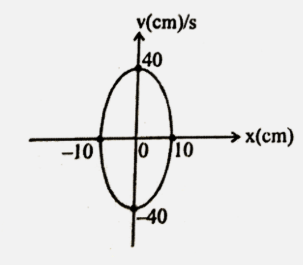A particle executes simple harmonic motion according to equation . Its time period of oscillation is :-
The correct Answer is:C
Step by step video, text & image solution for A particle executes simple harmonic motion according to equation 4(d^(2)x)/(dt^(2))+320x=0. Its time period of oscillation is :- by Physics experts to help you in doubts & scoring excellent marks in Class 12 exams.
Topper's Solved these Questions
- BOOK - AAKASH INSTITUTECHAPTER - OSCILLATIONSEXERCISE - Assignment (Section - B) (OBJECTIVE TYPE QUESTIONS)30videos
OSCILLATIONS
- BOOK - AAKASH INSTITUTECHAPTER - OSCILLATIONSEXERCISE - Assignment (Section C) (PREVIOUS YEARS QUESTIONS)43videos
OSCILLATIONS
- BOOK - AAKASH INSTITUTECHAPTER - OSCILLATIONSEXERCISE - Exercise20videos
OSCILLATIONS
- BOOK - AAKASH INSTITUTECHAPTER - NUCLEIEXERCISE - ASSIGNMENT (SECTION-D)10videos
NUCLEI
- BOOK - AAKASH INSTITUTECHAPTER - PHYSICAL WORLDEXERCISE - ASSIGNMENT (Section-B)5videos
PHYSICAL WORLD
Similar Questions
The plot of velocity (v) versus displacement (x) of a particle executing simple harmonic motion is shown in figure. The time period of oscillation of particle is :-
 View Solution
View SolutionA particle executes simple harmonic motion of period 16s. Two seconds later after it passes through the center of oscillation its velocity is found to be 2m/s. Find the amplitude.
View Solution
Knowledge Check
- Question 1 - Select One
If a simple harmonic motion is erpresented by d2xdt2+ax=0,
its time period is.A2π√aB2πaC2π√aD2πa - Question 2 - Select One
If a simple harmonic motion is represented by d2xdt2+αx=0, its time period is :
A2παB2π√αC2παD2π√α - Question 3 - Select One
If a simple harmonic motion is represented by d2xdt2+αx=0, its time period is :
A2παB2π√αC2παD2π√α
A particle is executing a linear S.H.M. and its differential equation is d2xdt2+αx=0. Its time period of motion is
View SolutionThe maximum velocity of a particle executing simple harmonic motion is v. If the amplitude is doubled and the time period of oscillation decreased to 1/3 of its original value the maximum velocity becomes
View SolutionThe equation of a simple harmonic motion of a particle is d2xdt2+0.2dxdt+36x=0. Its time period is approximately
View SolutionIf the displacement (x) and velocity (v) of a particle executing simple harmonic motion are related through the expression 4v2=25−x2, then its time period is given by
View SolutionA particle executing simple harmonic motion with time period T. the time period with which its kinetic energy oscillates is
View Solution

